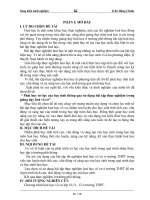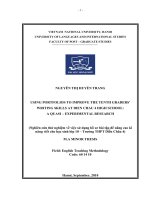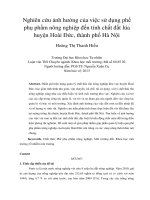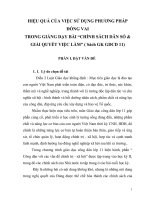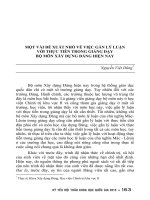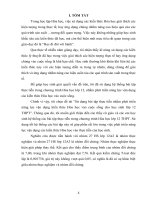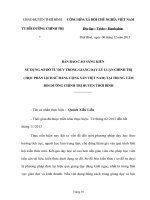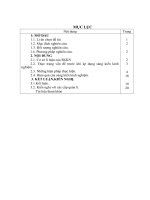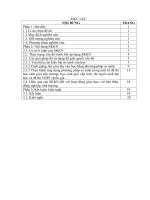NGHIÊN CỨU CÁ THỂ VỀ VIỆC SỬ DỤNG TÀI LIỆU THỰC TẾ TRONG GIẢNG DẠY KỸ NĂNG NGHE CHO HỌC SINH THPT TẠI HÀ NỘI
Bạn đang xem bản rút gọn của tài liệu. Xem và tải ngay bản đầy đủ của tài liệu tại đây (1.85 MB, 73 trang )
VIETNAM NATIONAL UNIVERSITY, HANOI
UNIVERSITY OF LANGUAGES AND INTERNATIONAL STUDIES
FACULTY OF ENGLISH LANGUAGE TEACHER EDUCATION
GRADUATION PAPER
A case study on using authentic
materials in teaching Listening for
high school students in Ha Noi
Supervisor: HOANG HONG TRANG, M.A
Student: TRAN NHAT ANH
Year of enrollment: QH2010
Hanoi – 2014
ĐẠI HỌC QUỐC GIA HÀ NỘI
TRƯỜNG ĐẠI HỌC NGOẠI NGỮ
KHOA SƯ PHẠM TIẾNG ANH
KHOÁ LUẬN TỐT NGHIỆP
NGHIÊN CỨU CÁ THỂ VỀ VIỆC
SỬ DỤNG TÀI LIỆU THỰC TẾ
TRONG GIẢNG DẠY KỸ NĂNG NGHE
CHO HỌC SINH THPT TẠI HÀ NỘI
Giáo viên hướng dẫn: Th.s Hoàng Hồng Trang
Sinh viên: Trần Nhật Anh
Khoá: QH2010
HÀ NỘI – NĂM 2014
ACCEPTANCE
I hereby state that I: Tran Nhat Anh, class QH. 2010. F1. E9, being a candidate for
the degree of Bachelor of Arts (TEFL) accept the requirements of the College relating
to the retention and use of Bachelor’s Graduation Paper deposited in the library.
In terms of these conditions, I agree that the origin of my paper deposited in the
library should be accessible for the purposes of study and research, in accordance
with the normal conditions established by the librarian for the care, loan or
reproduction of the paper.
Signature
Hanoi, May 5, 2014
ACKNOWLEDGEMENTS
I am absolutely conscious that I could not complete this thesis without the
help of others. In this occasion, I would like to take a chance to express my deepest
gratitude to them.
First and foremost, I would like to express my sincere gratitude and
appreciation to my supervisor, Ms Hoang Hong Trang for her acceptance to be my
supervisor, and for providing me with insightful and valuable comments. From the
point of a teacher, an advisor and an instructor, she suggested and encouraged me to
do this research. Thanks to her instructions and encouragement, I could carry out
this study successfully.
I would like to thank my family for their constant and endless source of love,
support and encouragement. They have been always by my side whenever I have
had difficulties and tiredness.
I would also want to extend a special shout-out to all the research
participants. The project would not have been accomplished without their
responsible and valuable ideas and opinions in the questionnaire.
Finally, my special thanks go to my dear friends for their understanding and
assistance during the process of doing this research.
All these people play remarkable roles in this research. I once more time say
my most sincere thanks to all of them.
i
ABSTRACT
This study was conducted with the attempt to explore the reality of materials
used in teaching and learning English listening skill in Nguyen Thi Minh Khai high
school in Hanoi and the attitude of teachers and students to the use of authentic
materials in teaching listening in this school. In order to do so, two English listening
skill teachers and 42 tenth form students in Nguyen Thi Minh Khai high school were
invited to take part in the survey questionnaires. After data were analyzed both
quantitatively and qualitatively, it was found out that authentic materials were
sometimes used besides the course books and both teachers and students have
positive attitude towards the use of authentic materials in teaching and learning
listening despite some possible difficulties caused by this type of materials.
ii
TABLE OF CONTENTS PAGE
Acknowledgements i
Abstract ii
Table of contents iii
List of figures vii
CHAPTER 1: INTRODUCTION
1.1. Rationale for the study 1
1.2. Objectives of the study 3
1.3. Research questions 3
1.4. Significance of the study 3
1.5. Scope of the study 4
1.6. Organization 4
CHAPTER 2: LITERATURE REVIEW
2.1. Listening as a skill
2.1.1. Definition of listening 5
2.1.2. Status of listening skill in an English language curriculum 6
2.1.3. Difficulties of learners with listening 8
iii
2.2. Authentic Materials
2.2.1. Definition of Authentic Materials 9
2.2.2. Classification of Authentic Materials 10
2.2.3. Advantages of Authentic Materials 11
2.2.4. Disadvantages of Authentic Materials 12
2.2.5. Criteria to choose Authentic Materials 13
2.3. Related studies on using Authentic Materials in teaching listening 16
CHAPTER 3: METHODOLOGY
3.1. Case study method
3.1.1. Reasons for choosing case study method 19
3.1.2. An overview of Nguyen Thi Minh Khai high school 19
3.2. Selection of subjects 20
3.3. Data collection instrument 21
3.4. Procedures of data collection
3.4.1. Questionnaire for teachers 23
3.4.2. Questionnaire for students 24
3.5. Procedures of data analysis 24
CHAPTER 4: RESULTS AND DISCUSSION
4.1 Results
4.1.1. Questionnaire for teachers
iv
4.1.1.1. The current situation of teaching and learning
listening in Nguyen Thi Minh Khai high school 26
4.1.1.2. The types of materials used for teaching
listening for high school students in Ha Noi 27
4.1.1.3. The attitude of teachers in Nguyen Thi Minh Khai
high school towards the use of authentic materials
in teaching listening 27
4.1.2. Questionnaire for students 29
4.1.2.1. Students’ self refection on their listening skill 29
4.1.2.2. The reality of materials used in teaching and learning
listening in Nguyen Thi Minh Khai high school 35
4.1.2.3. The attitude of students in Nguyen Thi Minh Khai
high school towards the use of authentic materials
in learning listening 35
4.2. Discussion
4.2.1. The reality of materials used in teaching and learning
listening in Nguyen Thi Minh Khai high school 38
4.2.2. The attitude of teachers and students in Nguyen Thi Minh Khai
high school towards the use of authentic materials
in teaching listening 39
4.2.3. Overcoming the constraints 42
4.2.3.1. Vocabulary 42
4.2.3.2. Speed 45
v
4.2.3.3. Time consuming of choosing authentic materials 46
4.2.3.4. Unavailability of equipment 49
CHAPTER 5: CONCLUSION
5.1. Summary of findings 50
5.2. Limitations 51
5.3. Suggestions for further research 51
REFERENCES 53
APPENDICES 58
Appendix A: Questionnaire for students
Appendix B: Questionnaire for teachers
vi
LIST OF FIGURES PAGE
1. Figure 1: Difficulties in listening faced by tenth form
students in Nguyen Thi Minh Khai high school 30
2. Figure 2: Purposes of learning listening of tenth form
students in Nguyen Thi Minh Khai high school 31
3. Figure 3: Activities to practice listening of tenth form
students in Nguyen Thi Minh Khai high school 32
4. Figure 4: Sources of authentic listening materials exposed
by tenth form students in Nguyen Thi Minh Khai high school 33
5. Figure 5: Frequency of exposure of authentic listening materials
by tenth form students in Nguyen Thi Minh Khai high school 34
6. Figure 6: Reasons students prefer authentic listening materials
to materials in textbooks 36
7. Figure 7: Reasons students prefer materials in textbooks
to authentic materials 37
vii
CHAPTER 1: INTRODUCTION
1.1. Rationale for the study
In the contemporary globalized world, people realize the importance of
English listening skill in communication in general and in work in particular. In
order to communicate with others successfully, people should listen well to
understand what their communicator is talking about. In addition, speaking skill, i.e.
a productive skill, is normally the one which impresses others at the beginning of the
conversation; however, it is the receptive skills like listening skill that acts as the
basis for speaking skill to flourish. As a result, English listening skill has become a
key factor for people who want to socialize with foreigners and then, one of the
decisive requirements for having a well-paid job. It is also the reason why there are
more and more English listening courses which aim at helping learners improve
their listening skill.
Next, teaching listening in high schools is emphasized by Vietnam’s Ministry
of Education and Training. According to The guidance for high school education in
English in 2013 – 2014, listening must be assessed at least once in each semester
besides being tested in the end term test which has not been implemented before. It
can be inferred that teaching and learning listening in high schools has been
increasingly concerned. Vietnam’s Ministry of Education and Training requires high
school teachers and students to focus much more on listening skill. In addition, the
Ministry encourages teachers to apply new methods in order to improve the quality
of teaching and learning for high school students (The guidance for high school
education in English in 2013 – 2014).
In order to help students to improve their listening skill, there are several
effective ways. Among them, using authentic listening materials is considered to be
of great help. The topic about authenticity of teaching materials itself has had a long
1
history beginning from 1890s. Until now, most of the researchers consider authentic
materials as beneficial in teaching and learning English skill (Henry Sweet (1899),
Little, Devitt, & Singleton (1988), Lee (1995), Gebhard (1996), Peacock (1997),
Shrum and Glisan (2000), Shei (2001), Lin (2004), Khaniya (2006) and Oguz and
Bahar (2008)). Moreover, authentic materials are available in our life. According to
Gebhard (1996), there are unlimited sources for teaching materials. For those who
live in countries where English is a foreign language, it is simply a matter of
searching creatively. Teachers in urban areas of these countries can access authentic
materials from cable TV, English language newspapers and magazines, and even
from popular music on the radio. In large cities, modern grocery and department
stores carrying imported products and the tourist industry such as hotels can offer
useful authentic resources. Or else, during travel to English-speaking countries,
teachers could pick up useful materials that could be adapted for their English
lessons. In fact, Viet Nam is not an English speaking country, however, in the
technological era, mass media such as the Internet, cable television and radio which
contain nothing but authentic materials are accessible for almost all high school
students, especially those in big cities like Hanoi. Furthermore, in comparison with
listening materials given in course books which are modified to be suitable for
students’ level, authentic materials are close to life and challenging. Therefore, it
might be possible to use authentic materials to motivate high school students to
listen and facilitate their listening skill so as for them to listen better.
For those main reasons, the researcher has decided to do research into “A
case study on using authentic materials in teaching listening for high school
students in Hanoi”. Hopefully, the research could contribute to the literature on
using authentic materials to improve four language skills in an English-as-a-foreign-
language environment like Vietnam
1.2. Objectives of the study
2
In this study, the researcher would like to concentrate on finding out the kinds
of materials used in teaching English listening for high school students in Nguyen
Thi Minh Khai high school in Hanoi and analyzing the attitude of teachers and
students in this school towards using authentic materials in teaching and learning
listening.
1.3. Research questions
Based on the purposes mentioned above, the study aims at answering the
following specific research questions:
1. What types of materials are being used in teaching listening in Nguyen
Thi Minh Khai high school in Hanoi?
2. What is the attitude of teachers in Nguyen Thi Minh Khai high school
towards the use of authentic materials in teaching listening?
3. What is the attitude of students in Nguyen Thi Minh Khai high school
towards the use of authentic materials in learning listening?
1.4. Significance of the study
Although the study was conducted as a small scale one, the researcher does
hope that the results could raise teachers’ awareness of advantages of using
authentic materials in their language teaching and may point out possible difficulties
for teachers and students when teaching and learning with authentic materials so that
teachers can be better prepared if they have an intention of using these materials in
the future.
Hopefully, the study could contribute to the improvement in quality of
teaching and learning English listening in particular and English language in general
in not only Nguyen Thi Minh Khai high school, but also other high schools in
Hanoi.
1.5. Scope of the study
In the study, the researcher only focuses on investigation of the use of
authentic materials in teaching listening, not other language skills. Besides, due to
3
limited resources, the subject for research is limited to one 10th grade class and two
teachers of English in Nguyen Thi Minh Khai high school, Tu Liem District, Hanoi.
1.6. Organization
Chapter 1 Introduction presents an overview of the thesis including rationale,
objectives, research questions, significance, scope and organization of the thesis.
Chapter 2 Literature Review provides a theoretical background for the study
including related theories and/ or studies about listening as a skill, and using
authentic materials in language teaching.
Chapter 3 Methodology details the method employed to carry out the research
together with data collection instrument, participants, procedures of data collection
and method of data analysis.
Chapter 4 Results and Discussion presents and discusses the results of the
research and some suggestions for overcoming constraints of the use of authentic
materials in teaching listening for students in Nguyen Thi Minh Khai high school.
Chapter 5 Conclusion summarizes the main findings, draws the conclusion,
acknowledges the limitations of the study and suggests further study.
CHAPTER 2: LITERATURE REVIEW
2.1. Listening as a skill
2.1.1. Definition of listening
4
Among four language skills, the most frequently used skill in the course of a
daily life is listening (42%), followed by speaking (32%), reading (15%) and writing
(11%). Therefore, it could be said that listening is the most important skill for
communication. Saricoban (1999) insists that listening is one of the fundamental
language skills. It is a medium through which children, young people and adults
gain a large portion of their information, their understanding of the world and of
human affairs, their ideals, sense of values and their appreciation.
Regarding the term “listening”, there are various definitions given by
language researchers.
According to Anderson and Lynch (1988), listening is an internal process,
which cannot be observed directly. This means it is difficult to assess whether the
listener has effectively used the skills at a particular occasion, what listening
strategies are employed, which source of information is dominantly used, and what
problems the listener experiences. This distinctive feature of listening might lead to
the view that listening is a passive skill in which the listener simply receives a
spoken message. Thus, listening remained the least understood and studied in the
language teaching/learning area (Rost, 1990; Morley, 1991; Vandergrift, 1999).
On the contrary, listening skill has received a considerable attention today.
Also, the perceptions towards listening are different. Unlike Anderson and Lynch
(1988) considering listening as a passive skill, Rost (1991) affirms that “listening is
an active process requiring participation on the part of the listener” (p.21). Agreeing
with Rost (1991), Vandergrift (1999) believes listening comprehension is a
complex, active process including discriminating between sounds, understanding
vocabulary and grammatical structures, interpreting stress and intonation, and then
combining with the larger socio-cultural context of the utterance. There are various
opinions on factors included in listening process from which the hearer could
understand the message sent from the speaker. For example, according to
Vandergrift (1999), as mentioned above, they are vocabulary, grammar, stress and
5
intonation. However, Oxford (1993, p. 206) refers that together with perception of
the sound, “listening includes comprehension of meaning of words, phrases, clauses,
sentences and connected discourse.” In the opinion of River’s (1987), listening
activity needs to integrate skills of language, such as pronunciation, vocabulary
mastery, writing, speaking, and reading.
In this research, a simple definition of listening proposed by Keith Morrow
and Keith Johnson (1998) would be adopted. According to those, listening refers to
the ability to understand how a particular sentence relates to what else has been said
and its function in the communication.
2.1.2. Status of listening skill in an English language curriculum
Despite the fact that listening plays a critically important role in both
language learning, communication, academic pursuit and current English curriculum
(Rost, 2002; Vandergrift, 2004), it remains the least researched and understood of all
four language skills (Nation & Newton, 2009) and “such neglect is surprising”
(Hedge, 2003, p. 228). While the other three language skills, i.e., reading, writing,
and speaking, received direct instructional attention, listening skill in language
learning was regarded as a solely passive activity (Mendelsohn, 1984: Oxford,
1993). In teaching listening, teachers often expected students to develop their
listening skill by Audio-lingual method and without assistance (Mendelsohn, 1984).
In the Audio-lingual approach, it is believed that if students listen to the target
language all day, they will improve their listening comprehension skill through the
experience. The fact that listening has been neglected or poorly taught may have
stemmed from the belief that it is a passive skill and that merely exposing students
to the spoken language provides adequate instruction in listening comprehension
(Call, 1985).
6
In addition to the American Audio-lingual Approach, the English language
teaching programs of the British Situational Approach did not pay much attention to
listening beyond its role in grammar and pronunciation drills and learners’ imitation
of dialogues during the 1940s, 1950s, and 1960s (Morley, 2001).
Arguments for listening comprehension began in the mid-1960s by Rivers
(1966) who said that “Speaking does not itself constitute communication unless
what is being said is comprehended by another person” and that “Teaching the
comprehension of spoken speeches is therefore of primary importance if the
communicative aim is to be reached”. In 1969, at the Second AILA (International
Association of Applied linguistics) Conference held in Cambridge, England, the role
of teaching and learning listening was focused on through new views on the
importance of the following issues: (a) individual learners and the individuality of
learning, (b) listening and reading as non-passive and very complex receptive
processes, (c) listening comprehension’s being recognized as a fundamental skill,
and (d) real language used for real communication as a viable classroom model
(Morley, 2001). Then, slowly and steadily, more attention has been given to
listening comprehension.
In the 1970s, listening began to be regarded as the status of central
importance. Instructional programs expanded their focus on pragmatic skills to
include listening as well as reading, writing, and speaking. During the 1980s, as
researchers became increasingly interested in exploring the details of this complex
skill, more research, theory building, and curriculum development on listening
comprehension were done. Throughout the 1990s, attention to listening in language
teaching increased dramatically. Listening is now considered as an active skill that
involves many processes. Byrnes (1984) characterizes listening comprehension as a
“highly complex problem-solving activity” that can be broken down into a set of
distinct sub-skills. As Richards (1985) points out, “current understanding of the
nature of listening comprehension draws on research in psycholinguistics,
7
semantics, pragmatics, discourse analysis, and cognitive science”. In order to
comprehend spoken messages, listeners may need to integrate information from a
range of sources: phonetic, phonological, prosodic, lexical, syntactic, semantic, and
pragmatic.
2.1.3. Difficulties of learners with listening skill
Despite the importance of listening in teaching and learning language, it
could not be denied that it is a difficult skill to both teachers and learners. In order to
prove this opinion, Ghaderpanahi (2012) points out three factors which could make
it difficult and confusing for learners in their listening process. They are layers of
sound which are at different volumes and speeds and often with frequent
interruptions, accents and intonation.
In addition to three factors above, according to Underwood (1989), the
reasons which make listening difficult could be not only related to the speaker, but
from the listener as well, including: listener’s inability to control the speed of
delivery, to recognize the signals in listening and concentrate on a foreign language,
listener’s limited vocabulary, listener’s shortage of contextual knowledge and
listener’s worry about failure of understanding every word in listening.
There are also other problems identified by other writers such as problems
concerning how to approach the task of decoding spoken English (Brown, G., 1990;
Carrier, 1999; Chien & Wei, 1998), difficulties in understanding reduced forms,
distinguishing word boundaries and recognition of non prominent words (Cauldwell,
1996), short term memory capacity (Call, 1985; Ellis, 1996; Rost, 1990) and
learners may lose their interest in the topic or the activity (Rost, 1990).
2.2. Authentic materials
8
2.2.1. Definition of authentic materials
The definitions of authentic materials are slightly different in literature
written by different language researchers. Nunan (1989, as cited in Adams, 1995)
refers to authentic materials as any material that has not been specifically produced
for the purpose of language teaching. To be more specific, Widdowson (1990) noted
that “Authentic materials would be materials designed for native speakers of English
used in the classroom in a way similar to the one it was designed for”. For example,
a radio news report brought into the class so students discuss the report on pollution
in the city where learners live. Similarly, Harmer (1991) defined authentic texts as
real texts designed for speakers of the language, not for language students. Jordan
(1997) seemed to be in agreement with Harmer (1991) when he referred to authentic
texts as texts that were not written for language teaching purposes.
In short, this research adopts the view of Nunan (1989), Widdowson (1990),
Harmer (1991) and Jordan (1997) mentioned above, that is, authentic materials are
considered as the kind of materials designed for native speakers out of purpose of
learning language.
2.2.2. Classification of authentic materials
Gebhard (1996) based on the presentation of the materials to classify
authentic materials teachers could use in their classes into four categories and gave
examples for each category:
9
1. Authentic Listening - Viewing Materials TV commercials, quiz shows,
cartoons, news clips, comedy shows, movies, soap operas, professionally audio
taped short stories and novels, radio ads, songs, documentaries, and sales pitches.
2. Authentic Visual Materials slides, photographs, paintings, children’s
artwork, stick-figure drawings, wordless street signs, silhouettes, pictures from
magazines, ink blots, postcard pictures, wordless picture books, stamps, and X- rays.
3. Authentic Printed Materials newspaper articles, movie advertisements,
astrology columns, sports reports, obituary columns, advice columns, lyrics to
songs, restaurant menus, street signs, cereal boxes, candy wrappers, tourist
information brochures, university catalogs, telephone books, maps, TV guides,
comic books, greeting cards, grocery coupons, pins with messages, and bus
schedules.
4. Realia (Real world objects) used in classrooms coins and currency, folded
paper, wall clocks, phones, Halloween masks, dolls, and puppets, to name a few.
(Realia are often used to illustrate points very visually or for role-play situations)
Differently, according to Mathew et al (1991), there are four types of
authentic listening materials based on what listeners listen to in their daily life in
native language. They are songs, conversation, news broadcast and films which are
taken from various sources such as tape recorder, radio, TV, video, computer
software and CD – Room and the Internet network based communication as well.
In this research, the researcher would apply the broader classification of
authentic materials of Gebhard (1996).
2.2.3. Advantages of authentic materials
There are some advantages of using authentic materials in teaching listening.
According to Philips and Shettlesworth (1978), Clarke (1989), Peacock (1997) and
Berardo (2006), authentic materials have a positive effect on student motivation. It
10
is also supported by Tamo, D. (2009) and Guariento and Morley (2001) who state
that since authentic materials are real they give the learners a sense of coping with a
living entity and they conclude that in order to promote motivation authentic
materials can be used. Different researchers such as Lee (1995), Little, Devitt &
Singleton (1988), Peacock (1997), and Shei (2001) also claim motivation effect of
authentic materials. This, according to Lin (2004), is because learners see authentic
materials as being only more interesting and stimulating. Oguz and Bahar (2008)
contend that if learners’ interaction with authentic materials is established with
interest and without difficulty they can participate actively in learning and in the
same way their motivation levels may raise.
Secondly, using authentic materials exposes students to real language.
Chavez (1998) agrees that using authentic materials is to the benefit of the students
because they are more enjoyable and students find a chance to interact with the
language and its use. According to Shrum and Glisan (2000), authentic materials
provide an effective means for presenting real language, integrating culture, and
heightening comprehension. They bring two reasons for believing that authentic
materials are beneficial. Firstly, by exposure to such materials, students will be
provided with the opportunity to see language as is used in real world to serve a real
purpose. Secondly, such materials can be considered as a rich source of cultural
content. In addition, Haley and Austin (2004) and Velazquez (2007) encourage the
use of authentic texts since they believe that such texts can provide a connection
between the students on one hand and the target language and culture on the other
hand. Also the teacher is provided with “more opportunities to bring the real world
aspects into the class” (p.93). Thus, it could be said that authentic materials not only
functions to provide students with real language used everyday by native speakers,
but give authentic cultural information as well.
11
Other advantages listed by experts are authentic materials are related more
closely to students’ needs, encourage to improve other language skills actively,
produce a sense of achievement and support a more creative approach to teaching.
2.2.4. Disadvantages of authentic materials
According to experts, authentic materials not only have advantages in
teaching and learning language, but also include disadvantages. For Kim (2000),
Guariento & Morley (2001) and Martinez (2002), authentic materials often contain
difficult language, unneeded vocabulary items and complex language structures
which cause a burden for the teacher in lower-level classes and discouragement for
low level students. Then, because students may be unable to understand authentic
language input, they could also experience frustration, which may negatively impact
their receptiveness to authentic material (Bacon & Finneman, 1990; Guariento &
Morely, 2000).
Secondly, the use of authentic materials is time consuming for the teachers
(Viney, 2006). The materials may be too difficult for students so the teacher will
need longer hours in planning and applying the materials, and most of all the
teachers may find it difficult to adjust the materials with the syllabus that the school
requires.
According to Murdoch (1999), another problem may come out when students
learn languages for the purpose of gaining success on an examination. In these
situations, teachers have to take the responsibility in achievement of their students.
Therefore, if students are presented with authentic text which may not give the rules,
patterns, or structures they need to pass an exam, it is not sure that they could get
high score in examinations which often require academic language learning.
12
Finally, there are other disadvantages: authentic materials require a good
knowledge of cultural background and become outdated easily (Tamo, D., 2009;
Kim, 2009, Guariento & Morley, 2001; Martinex, 2002).
2.2.5. Criteria to choose authentic materials
Authentic materials have some disadvantages as mentioned above, a careful
selection of these materials for use in the classrooms, therefore, should be paid high
attention to. Oguz and Bahar (2008:331) do not encourage random selection of
authentic materials. To be used effectively they mention that when choosing
materials there should always “be an aim in using them and chosen materials should
meet the objectives of the lesson”. Further, they point out that criteria such as
learners’ age, level, interests, needs, goals, and expectations must always be met.
In choosing authentic materials three other factors have been introduced by
Nuttal (in Berardo, 2006:62) as suitability, exploitability, and readability. Similar to
the opinion of Oguz and Bahar (2008), according to Nuttal, the most important
criterion, suitability, refers to the idea that texts must be chosen based on learners’
interest and they should be relevant to their needs. By exploitability he means the
way through which learners’ competence as readers may be developed. Readability
means choosing texts’ difficulty based on learners’ language level. Besides the
purpose and interest of learners, Rogers and Medley (1988) add some other
characteristics such as quality, appropriateness, and naturalness of the language
which must be considered and for Shomoossi et al. (2007) it is the context of use
needs. Galloway (1990) recommends the following criteria in authentic material
selection:
1. Topic should be accessible to learners
2. Length of text should not be intimidating to beginning readers
13
3. Linguistic level should be slightly above the reader’s own level unless
the tasks are closely structured to involve focused reading
4. Clues to meaning should be abundant such as contextual, verbal,
pictorial, and linguistic.
(Cited in Haley and Austin, 2004: 160-161)
In agreement with Galloway (1990), according to Tungesh G.M (2012), it is
the most important for teachers to choose authentic materials suitable for interest of
students and the proficiency level of the class. Of them, the latter is also mentioned
by Fei and Yu-feng (2008) as a determining factor in choosing appropriate authentic
materials. In order to have the best choice, Tungesh G.M (2012) proposed some
suggestions: (1) select shorter texts or articles with simpler, less complex language,
(2) use extracts from longer articles, (3) select topics that are likely to be of interest
to the learners, too, (4) most of these materials contain a lot of visuals that can be
used as interesting stimuli to generate language, (5) particularly, brochures,
magazines and newspapers are readily available and teachers should look out for
these and collect and compile them for use in the classrooms (p.107).
Different from Galloway (1990) and Tungesh G.M (2012) in terms of
complexity level of the materials, Spelleri (2002) gives that recommendation that it
must be slightly beyond learners’ level for increasing motivation, awareness, and
curiosity. Karpova (1999) provides a list of the criteria which need to be considered
when using authentic materials as follows:
1. Content: the content of authentic materials has to be appropriate for
learners’ age, interest, needs and goals.
2. Tasks: tasks must be “sequenced and differentiated” and must include
“communicative and cognitive procedures” so that the learners’ background and
new knowledge can be integrated.
3. Teacher-learner relationship: the materials must be structured in a way that
a “reciprocal” interaction between the instructor and the learner takes place.
14
4. Learning strategies: cognitive abilities of the learners must be improved by
paying attention to learning strategies.
5. Learning environment: the environment provided must in a way encourage
“risk taking and idea sharing”.
6. Social Values and Attitudes: authentic materials must be a reflection of
social values and attitudes.
7. Culture issue: authentic materials must further learners’ “cultural,
sociolinguistic, and paralinguistic awareness”.
In terms of authentic listening materials, Valencia (1991) and Karpova (1990)
reported some guidelines for selecting authentic listening materials. Their guidelines
are as follows:
1. Authentic listening materials should reflect important themes and ideas
2. Authentic listening materials should be consistent with the goals of the
subject area curriculum in your district.
3. Authentic listening materials should be rooted in real world experiences
and have application to the world both inside and outside school.
4. Authentic listening materials should be sensitive to the developmental
progression of students.
5. Authentic listening materials should allow students to engage in higher
order thinking (Valencia, 19910, p. 590 – 591).
Karpora (1999) [cited in (Su, 2007, p. 50)] also provided several guidelines
for selecting authentic listening materials including: (1) content: authentic listening
material should be content appropriate to the age, interests, needs, and goals of
students. (2) Tasks authentic listening materials should contain tasks that present
cognitive and communicative procedures that students could apply to their new
knowledge in the collective exploration. (3) Teacher – learner relationship: authentic
listening material should be balanced between instructors and students „expectations
15

